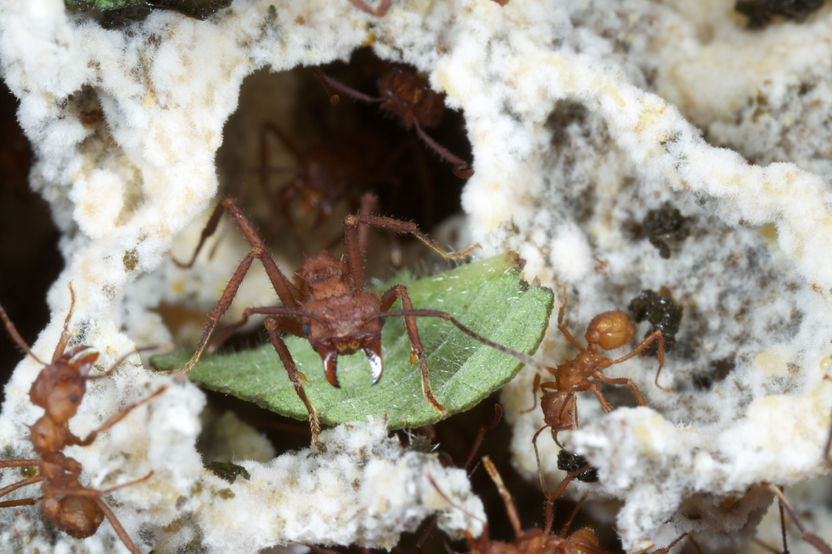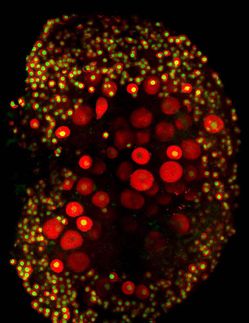Fungus farming ant genome reveals insight into adaptation of social behavior
Advertisement
The development of agriculture was a significant event in human cultural evolution, but we are not the only organisms to have adopted an agricultural way of life. In a study published in Genome Research, researchers have sequenced the genome of a fungus farming leaf-cutting ant, revealing new insights into the genetics and molecular biology behind this unusual lifestyle.

The Panamanian leaf-cutting ant Acromyrmex echinatior farms fungus on leaf fragments for food. Minor workers tend the fungus garden and nurse the brood, major workers defend the colony and bring in new leaf fragments.
© David R. Nash
Found in Central and South America as well as the southern United States, leaf-cutting ants have evolved a symbiotic relationship with fungus. By breaking down leaves into mulch, the ants help the fungus to grow special structures for large societies of ants to feed upon.
Since being recognized as a new Panamanian species about 15 years ago, much has been learned about the biology of the leaf-cutting ant Acromyrmex echinatior, but the genetic basis of their farming lifestyle remained largely unknown. In this report, an international team of researchers has sequenced the genome of A. echinatior, and by comparison to other ant and insect genomes, identified genomic clues to the evolution of fungus farming behavior.
The authors noted that one of the most interesting findings in the genome of this leaf-cutting ant was that there are more genes in two particularly noteworthy gene families. “Based on their function in other organisms, we expect them to be involved in mating system adaptations and symbiotic food processing with the fungus,” said Dr. Sanne Nygaard of the Copenhagen Centre for Social Evolution, co-lead author of the study.
Nygaard explained that these findings are especially fascinating because known evolutionary changes in the reproductive biology and farming lifestyle of these ants can now be linked to specific genomic features.
The authors also noted a particularly surprising result when comparing genes coding for neuropeptides, the small molecules that drive many biological processes, between the leaf-cutting ant and the sequenced genes of other ants with varied habitats, diets, and behaviors. They expected that differences in neuropeptide genes would be pronounced, but they found just the opposite.
“An identical set of neuropeptide genes is present in all the ant genomes we examined,” said Nygaard, “showing that these genes are remarkably conserved.” The authors suggest that the neuroendocrinology of all ants may have a very similar make-up, going back to the dawn of social evolution in the ancestor of all present ants.
“We are as yet only scratching the surface of the fascinating adaptations that will likely be revealed in the coming years,” added Dr. Jacobus Boomsma, Director of the Copenhagen Centre for Social Evolution and co-senior author of the report, explaining that the genome sequence and analysis performed here will set the stage for further insights into the biology of social behavior.
Original publication
Nygaard S, Zhang G, Schiøtt M, Li C, Wurm Y, Hu H, Zhou J, Ji L, Qiu F, Rasmussen M, Pan H, Hauser F, Krogh A, Grimmelikhuijzen CJP, Wang J, Boomsma JJ.; "The genome of the leaf-cutting ant Acromyrmex echinatior suggests key adaptations to advanced social life and fungus farming."; Genome Res.


























































